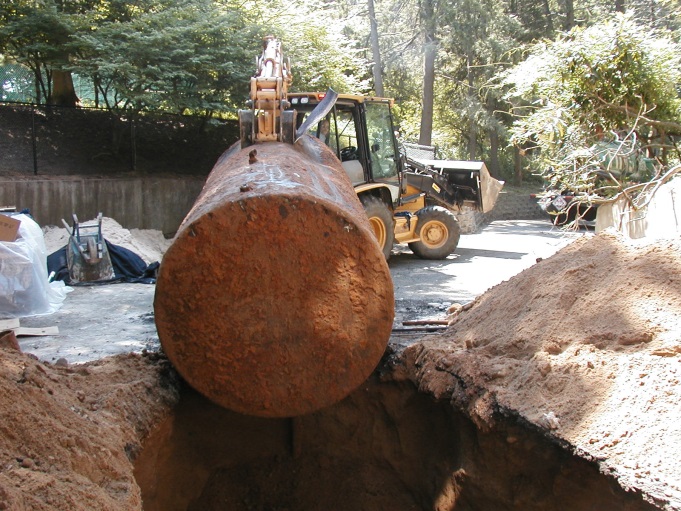Why Choose Us
Price Match Guarantee
Our pricing is as affordable and competitive as it gets. If another contractor offers you a better price for the same project, we will beat their bid by at least $100!
Estimates are always FREE and our pricing is extremely competitive. In order to ensure we are never underbid, we offer an unconditional Price Match Guarantee. Call today for a FREE, no obligation quote!

What is Oil Tank Abandonment or Decommissioning An Oil Tank?
If you have an oil tank outside your home, it is essential to get a proper check on the tank to assure of any possible residue remaining or leakages occurring. If an oil tank has leaked, it could cost you thousands of dollars to remediate the leakage. In order to figure out if you have an oil tank on your property, get a proper technician to locate possible tanks. It is typically recommended that a tank be removed once it is located, but size, location, and possible barriers may make it difficult for tank removal. Oil tank abandonment is another option which safety inactivates any oil tank.
Underground Oil Tank Abandonment
Oil Tank Abandonment occurs when the oil tank is left in place and is removed of any residue before being filled with sand or foam. Tank removal can be a difficult process as they can be located under decks, patios, in basements, and under home additions. Because tank removal is not always feasible, abandonment can be a convenient and cost efficient way in order to deal with old or leaking oil tanks. Because the tank is left in place, restoration of the property is minimal and can be an effective solution for tanks located in physically inaccessible locations around the property. In the process, the top of the tank is cut and removed in order to access the inside of the tank. All oil and residue are safely removed from the tank and disposed of within a licensed facility. After the tank has been properly cleaned, it is then filled with sand or foam. Filling the tank with a material removes any possibility of a tank leaking if the tank has been properly cleaned. After cleaning, any connecting pipes are disconnected from the tank, and the tank can be covered and concealed. By filling an oil tank, you are making the tank inactive, as it can no longer hold any liquids. Here are the regulations for Nassau County residents looking to remove, abandon or replace an old tank.
It is important to abandon any inactive oil tanks as they can expose the environment to pollution from oil leaks. Even abandoned oil tanks from previous property owners should allow for soil testing. Many homeowners who acquire a property with abandoned oil tanks are surprised to find that their abandoned oil tank has leaked because the tank may not have been properly cleaned during abandonment. Proper cleanup from oil leaks can go between $8,000 to $10,000, so it is essential to have a soil test done in order to avoid taking on someone else’s liability. Additionally, leaking oil tanks can be a health hazard to your home as the pollution can get into sewage systems, storm drains, and water supply. Due to the limited life expectancy of tanks, state and national laws require testing for underground tanks to ensure there have been no leaks, ruptures, or holes. It is also important to inspect the soil surrounding your oil tank for detection of any oil spills. If the oil is detected, it will be necessary to remove polluted soil and to replace it with fresh soil. By inspecting your oil tank, it will save you hundreds of thousands of dollars on future costs. A good resource to read is Underground Heating Oil Tanks: A Homeowner’s Guide from the Department of Environmental Conservation.
We can provide you with any of the following services:
- Oil tank abandonment Nassau County
- Oil tank abandonment Suffolk County
- Oil tank abandonment Long Island
- Oil tank abandonment cost estimate
- Foam filling underground tanks
- Cost to fill oil tank with sand
- Underground oil tank removal cost
- Oil tank removal Long Island
- UST Closure
- Oil tank installation
- Oil tank replacement
- Gasoline Stations UST Removal
- Sand oil tank abandonment
- Foam oil tank abandonment

The Difference Between Oil Tank Removal & Oil Tank Abandonment
It can often be difficult to decide the best way to properly dispose of an old oil tank. The best option will depend on your circumstances, and what type of oil tank you are trying to remove. Oil tank abandonment minimizes the amount of excavation done on the land and can be done fairly quickly. The second option will be oil tank removal. This comprises of emptying the remnants of the oil tank and excavating it out of the ground for complete disposal.
Oil Tank Removal Long Island
If it is necessary to remove an oil tank, it will need to be cleaned of all residue from within before the tank is dismembered into pieces. Doing so will allow easier disposal of the tank. Typically oil tanks are often deep within the ground and can be covered by concrete or pathways, making it difficult to complete the removal. To efficiently remove a tank, it may be necessary to obtain machinery and equipment which can remove concrete or pathways. Once a tank is removed, it is possible to return the area to its original state and to use the land as normal. This method reduces the risk of pollution and is recommended for populated areas.
Oil Tank Removal Cost
It is typically more costly to remove an oil tank than it is to abandon a tank. Above ground oil tank removal range from $408 to $1,001 with the average costs of removal being $696. For underground tanks, the average costs will start at $2,500 and go up depending on the tank size, its location and other factors. For most projects, it is required that a registered professional complete the work of removal to ensure the safe and legal disposal of hazardous liquids. When pricing oil tank removal, factors to consider when pricing an oil tank removal may include tank location, the size of the tank, any permits required, oil disposal, and soil testing. If an oil tank leaks, soil replacement is typically expensive and can cost $10,000 or more depending on the extent of the leakage.
Oil Tank Abandonment Long Island
If it is not possible to remove an oil tank, it may be necessary to abandon an oil tank at the location. This process can be done quickly while effectively removing any hazards of having an old oil tank on the property. In order to do so, it will be necessary to remove all risks relating to an oil tank. The first step to abandonment is to uncover the top of the tank, which may require some digging. The top portion of the tank is then cut away in order to identify if any remnants still remain. Remnants such as oil or sludge must be pumped out of the tank to be completely clean. Vents and pipes are then disconnected and removed from the tank. Once clean, the tank is then filled with sand or pea gravel before being covered with soil or concrete. The remaining oil is disposed of within a licensed facility.
Oil Tank Abandonment Cost
Abandonment can initially be a less costly method to reduce the dangers of an oil tank as typical costs include cleaning and filling the tank. Additionally, additional costs may include soil testing as pinhole leaks are possible, leading to possible contamination. While abandonment is typically cheaper and quicker, it is often likely that commercial land will be needed at some point in the future. Because of this, the cost of abandonment is usually added on to future excavation removal and can result in a higher total cost for the future. For most tanks, initial removal will have the highest cost efficiencies because of the possibilities for future land use.

 Free, No Obligation Estimate
Free, No Obligation Estimate